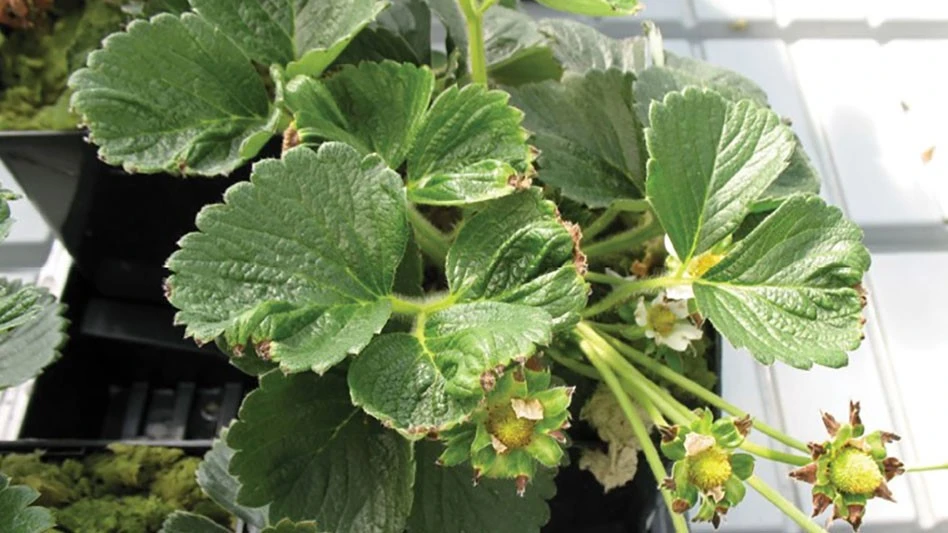

When strawberry plants are grown under relatively low night humidity (in dry climate or in an intensively heated greenhouse at night), tipburn and calyx burn may become problematic. Tipburn is a localized calcium deficiency that is typically initiated in the fast-growing shoot tip. The symptom may be first noticed as a darker-colored shoot tip, which later develops a necrotic distal end of leaf or calyx. Calyx burn is particularly problematic as it reduces cosmetic (visual) quality of strawberry fruit.
The localized calcium deficiency is often caused by limited allocation of calcium driven by mass flow (transpiration). In crops like lettuce, tipburn can be mitigated by increasing transpiration rate during the daytime. In strawberry, however, a more effective way to mitigate tipburn is not via increasing daytime transpiration, but by suppressing non-stomatal transpiration during the nighttime. Incidences of tipburn and calyx burn in strawberry can be reduced by lowering nighttime VPD (or increasing relative humidity) in the greenhouse.
Guttation and tipburn
Guttation is a good indicator of plant health in strawberry. Guttation occurs when the xylem pressure is high with all stomates closed and little non-stomatal transpiration under humid night condition (>95% at 15C or 0.1 kPa VPD). Guttation and tipburn incidence are known to be correlated. When plants are grown under conditions where guttation is rarely seen, these plants typically exhibit tipburn.
Under-bench misting system
For this reason, we started using below-trough misting to achieve 95% relative humidity at plant level for a minimum of three hours per night. This has been done by intermittently operating the misting system with blowers to enhance evaporation. Wetting plants directly by misting should be avoided, as it would increase the fungal disease incidence. As soon as three hours of high humidity are achieved, moisture can be released from the greenhouse to lower the humidity. Most cultivars do not seem to require this high humidity for hours every night, but some cultivars (e.g., Tochiotome) tend to be sensitive to tipburn inducing conditions and require more hours of high humidity every night.
Ca supplementation
While tip/calyx burn is a calcium deficiency, there is often sufficient amount of calcium in the root zone. Therefore, simply increasing calcium concentration in the nutrient solution does not solve the problem. A typical solution that growers attempt is a foliar calcium supply. It is recommended that applications should cover all shoot tips and growing leaves, not symptomatic leaves and calyx (because they are irreversible). The impact of foliar calcium application seems to be inconsistent, and also keeping plants wet all the time is the general concern of potential disease outbreak. For this reason, we usually recommend nighttime humidity management as a most effective method to mitigate tipburn.

Explore the December 2022 Issue
Check out more from this issue and find your next story to read.
Latest from Produce Grower
- TIPA Compostable Packaging acquires paper-based packaging company SEALPAP
- Divert, Inc. and General Produce partner to transform non-donatable food into Renewable Energy, Soil Amendment
- [WATCH] Sustainability through the value chain
- Growing leadership
- In control
- The Growth Industry Episode 8: From NFL guard to expert gardener with Chuck Hutchison
- 2025 in review
- WUR extends Gerben Messelink’s professorship in biological pest control in partnership with Biobest and Interpolis





